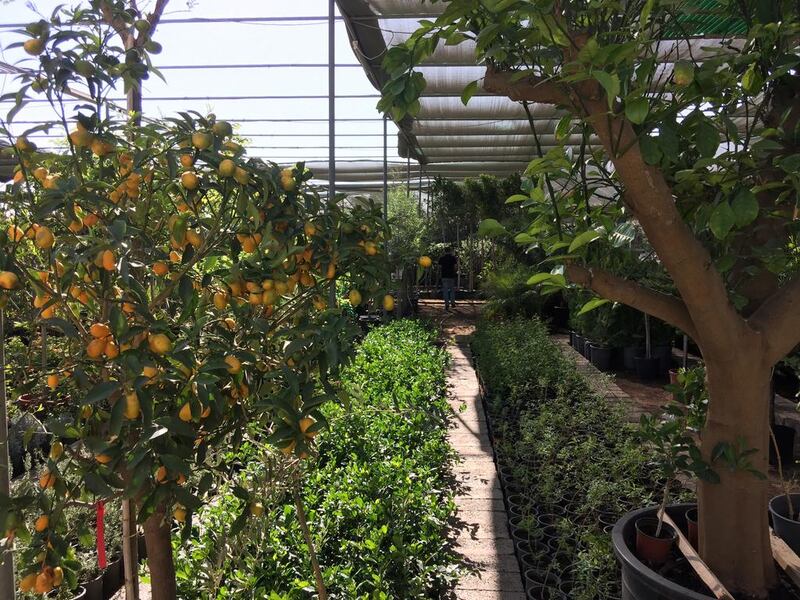It is said that you can’t put a square peg in a round hole, yet gardeners in the UAE routinely challenge convention, cultivating plants in soils and climates that are entirely alien to them.
Those planting fruit trees are perhaps the most adventurous of all. Here, an understanding of which specimens will adapt and which will not is particularly important. Many deciduous trees never properly cast off their leaves, as temperatures in the UAE don’t get cold enough. For fruit trees such as apples and pears, a cold snap is an essential stimulus for flowering and fruiting, and while such trees may occasionally be sold at local markets and nurseries in the UAE, cultivating these in the hope of ultimately harvesting juicy apples and pears is a little like pinning jelly to the wall.
Instead, gardeners should focus horticultural efforts on species that, with the right care, can adapt, survive and ultimately produce a crop. Most woody fruit trees take a little time to become established before fruiting – it can be three or four years for citrus – but many fruiting trees and plants also have aesthetic qualities that offset a gardening investment of several seasons.
Read more: 10 fruit trees good to grow in the UAE
Bruce Pedersen, nursery production, sales and technical manager at Marmara International Landscaping, trained as a horticulturalist in South Africa – largely because, as a young man, he identified this as a profession where he “wouldn’t ever have to wear a tie to work.” He has spent 25 years in the business of plants, seeds and landscaping, working in places such as Qatar, Sudan, Nigeria and the UAE – which means he is well placed to advise on which fruit trees to cultivate in this part of the world, and how to care for them.
“It’s better to invest in a smaller specimen as these are easier to establish, so something that is around 1.5 metres tall and 18 to 24 months old [for citrus] is ideal. It’s going to acclimatise a lot better than taking a mature orange tree, where there may be instant aesthetic gratification,” says Pedersen. Larger trees have to work that much harder to survive through summer, while a newly planted specimen may not have a sufficiently established root system to sustain it in a new location.
New trees can be planted any time from the end of summer, but it’s important to give them enough lead time to establish and build up reserves before they have to face the challenges of rising temperatures, and a period of dormancy over the summer months. If you start planting now, you’ll still be safe.
When buying plant specimens, ensure that they are stable in their container, rather than loose. “Look for straight stems with good lateral branches, check for crown deformities and also plant size in relation to container. Large plants squashed within small containers may have a compromised root system,” Pedersen advises.
“Compost twice a year and fertilise your plants just before the growing season. Papaya, banana and mango all need compost, but try not to dig it in, especially with citrus, as it will damage the surface roots. Instead, it should be layered around the plant and allowed to break down – advise your gardener not to rake it away before it’s done its job.”
When fruit trees are in flower, they should be fertilised with an organic mix containing nitrogen, potassium and phosphorus (NPK). Look for organic products designed for flowering plants or fruit trees, or feed for tomato plants, which works just as well. Feed up plants before the onset of summer to give them the necessary reserves as they slow down. Follow the directions given with the fertiliser or feed, and don’t overdo it or the plant will become soft and potentially more susceptible to insect infestation.
A surface application of neem oil is disruptive to the life cycle of insects and, as it is oil based, also suffocates red spiders. Washing down plants with a hosepipe from time to time will also dislodge some insects. Vinegar and water makes a very good fungicide and is useful for grapes. An application of flower of sulphur will also help.
Fruit-bearing woody plants and vines should be pruned after producing fruit, as they go into a dormant state. Take off the die back and trim down the central portion of the tree to clear the crown and allow the air to circulate between branches, which helps to reduce pests, as well as encourage new growth. Ideally, fruit trees should be pruned in such a way to allow more fruit to be available on the outside.
The majority of fruit trees available at plant markets here are imported, so none of them are traditionally grown in soil that is typical to the UAE. Specimens generally come from the Mediterranean region, including Spain, Italy and Turkey, as well as Iran and Iraq – all fruit-producing countries, but with very different conditions and soil. Before planting, water the pot well, add compost to the planting hole and also water this. Gently tease out some of the ends of the roots on the root ball, to give the tree a head-start before planting it in its new home.
Then, as with all good gardening, sit back, watch and wait to enjoy the fruits of your labour.
weekend@thenational.ae





